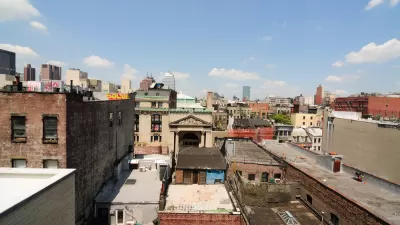Although Mayor Bill de Blasio's recent announcements provided some important details about his administration's affordable housing agenda, there are a few questions still left to be answered that will determine the success of the plan.
Greg David points to three numbers that—although not as compelling as the 200,000 total number of affordable units targeted by the plan—will determine how well the plan works in improving New York City's housing affordability troubles. The numbers are five (the total percentage increase in affordable housing units), seven (the targeted return on investment for housing developments), and eight (the total amount in billions of the city's planned in investment in affordable housing).
The problem with the five percent total growth in affordable housing, according to David: "So the plan may create affordable apartments for a group of New Yorkers, but it won't make the city more affordable as a whole because the housing supply won't increase enough to satisfy growing demand."
David goes on to detail the reasons the latter two figures mean that New Yorkers should temper their expectations about the overall impact of the plan.
FULL STORY: Mayor has a housing dilemma

Maui's Vacation Rental Debate Turns Ugly
Verbal attacks, misinformation campaigns and fistfights plague a high-stakes debate to convert thousands of vacation rentals into long-term housing.

Planetizen Federal Action Tracker
A weekly monitor of how Trump’s orders and actions are impacting planners and planning in America.

Chicago’s Ghost Rails
Just beneath the surface of the modern city lie the remnants of its expansive early 20th-century streetcar system.

Bend, Oregon Zoning Reforms Prioritize Small-Scale Housing
The city altered its zoning code to allow multi-family housing and eliminated parking mandates citywide.

Amtrak Cutting Jobs, Funding to High-Speed Rail
The agency plans to cut 10 percent of its workforce and has confirmed it will not fund new high-speed rail projects.

LA Denies Basic Services to Unhoused Residents
The city has repeatedly failed to respond to requests for trash pickup at encampment sites, and eliminated a program that provided mobile showers and toilets.
Urban Design for Planners 1: Software Tools
This six-course series explores essential urban design concepts using open source software and equips planners with the tools they need to participate fully in the urban design process.
Planning for Universal Design
Learn the tools for implementing Universal Design in planning regulations.
planning NEXT
Appalachian Highlands Housing Partners
Mpact (founded as Rail~Volution)
City of Camden Redevelopment Agency
City of Astoria
City of Portland
City of Laramie





























